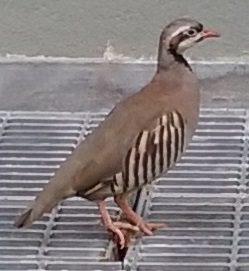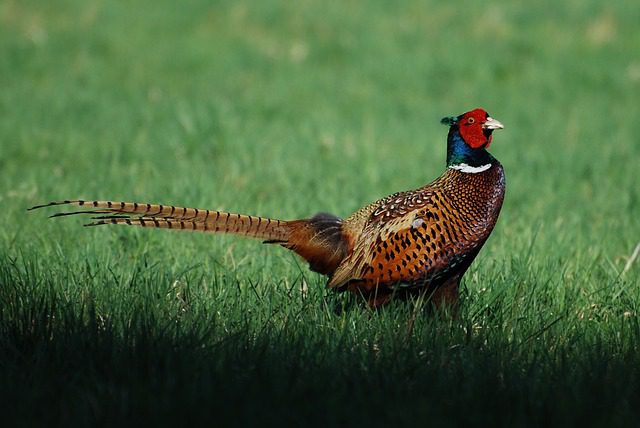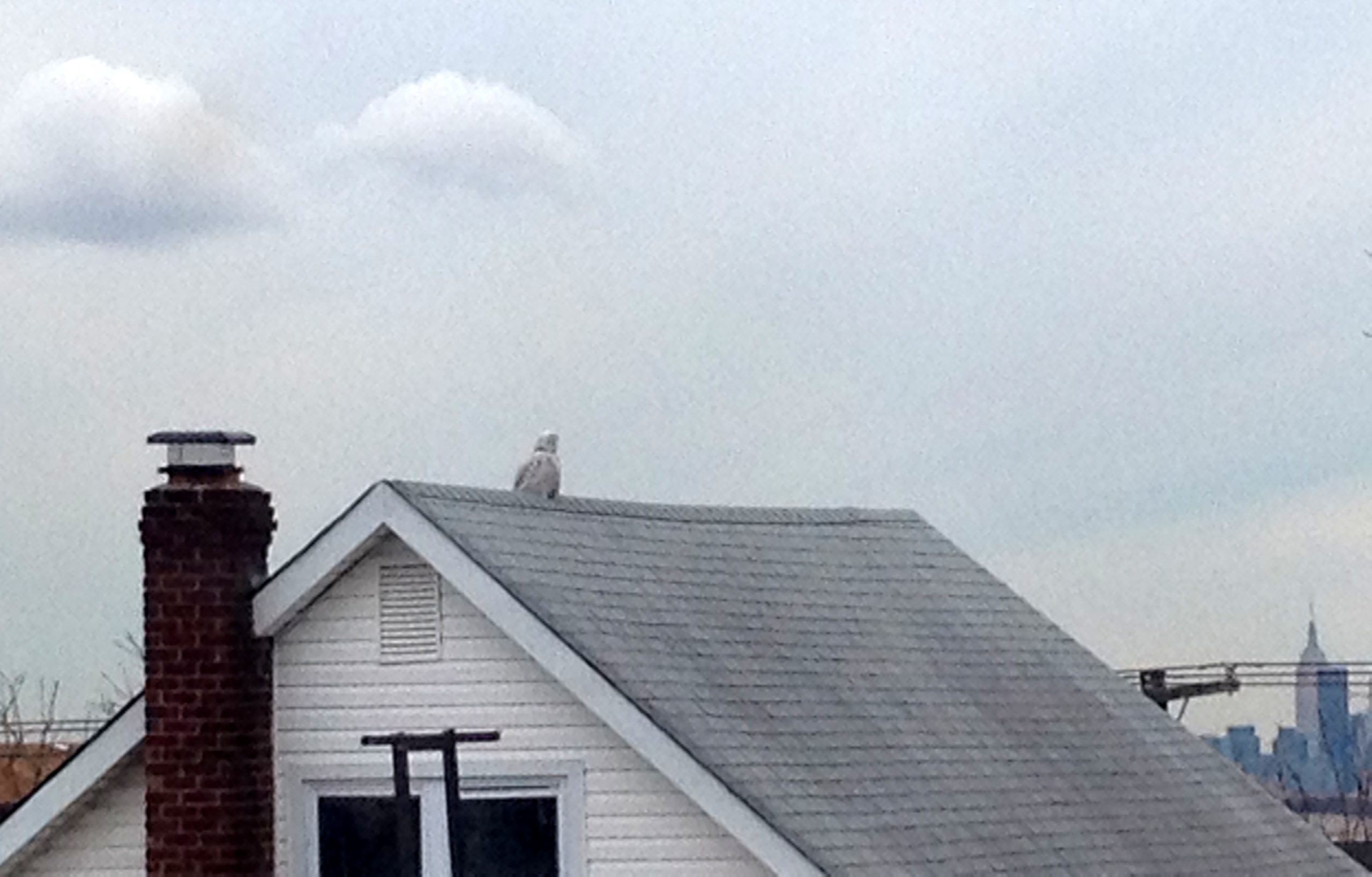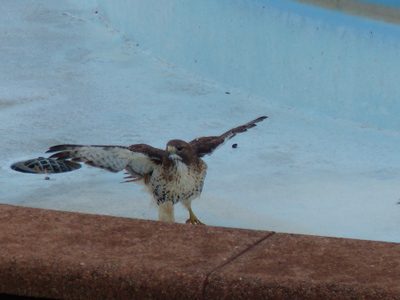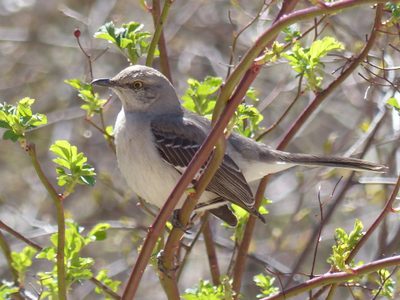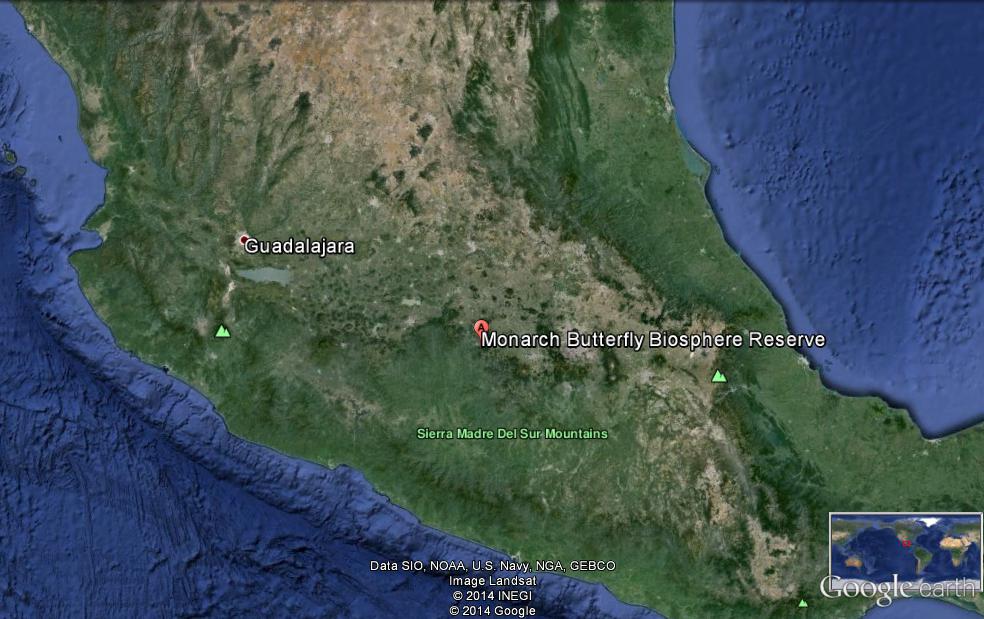Spring Peepers
by Peter Schmidt, 5/14/15
It was Wednesday April 28, at Frost Valley, and I was the a chaperon for my boys’ sixth grade class trip. When I heard all the frogs (spring peepers and I think tree frogs) peeping, I had to check it out. The first night I went by myself; the second night it was me, a teacher, a couple of other chaperones, and 60 kids. The frogs kept peeping the whole time. The camp is four hours north of the city, and although the weather was great, it was cooler than the City and none of the trees were budding yet.
Pheasants in New York City
Gladys Hechavarria, teacher at P.S. 86 in the Bronx, was surprised when a large pheasant appeared in the school garden (upper left). With the bird’s sharp beak, hawk-like plumage, long legs, and apparent inability to fly, she didn’t know what to make of it. So, Gladys called the local animal rehabilitation center and they glady accepted it. The next day, another Chukar appeared in the garden.
We think that the birds must have come from Van Cortlandt Park, 1.5 miles north of the school, but what they were doing at a tiny green space in an urban area is a mystery. We received word that these birds are Chukars, a type of Partridge that is native to southern Eurasia, and the national bird of Pakistan. Chukars were introduced to the U.S. from Pakistan to serve as game. birds. They now inhabit arid and rocky areas of the western U.S. and Canada.
The second featured bird is a close relative of the Chukar, the ring-necked pheasant. Probably the most colorful character in Queens, they are originally from Asia and have been naturalized to grasslands across the United States. I have observed these birds while I was walking along Flushing Main Street, passing Kissena Park. Mating pairs of ring-necked pheasants can be seen running around the meadows of Kissena Park and cruising the rolling lawns and cherry orchards of the Queen’s Botanical Garens.

Resident Red-Tailed Hawk on Campus Enjoying Lunch
Peter Schmidt, 3/30/15
As I was walking across the campus with my lunch, I saw one of our resident red-tail hawks land by a tree in the quad. I thought it was picking up a branch, as I had seen the pair of them building their nest on the fire escape of a neighboring apartment building. When the hawk didn’t start flying again though, I moved in for a better look. As you can see from the pile of feathers, the hawk had not been after a stick; it had been looking for lunch. Several people had walked by without noticing a thing.
Welcome to the Vernal Equinox
by Ken Chaya, 3/20/15
Welcome to the Vernal Equinox. As I gaze at the lovely snow storm outside my window, I must remind myself that spring officially started today (at 6:45pm). It appears that winter didn’t get the memo! Be that as it may, the days ahead will soon be full of dramatic seasonal changes as the daylight hours increase, and the temperature continues to gradually rise a little higher each day. Already I have observed a good deal of new activity—early blossoms and migrant birds arriving—just over the past week in Central Park.
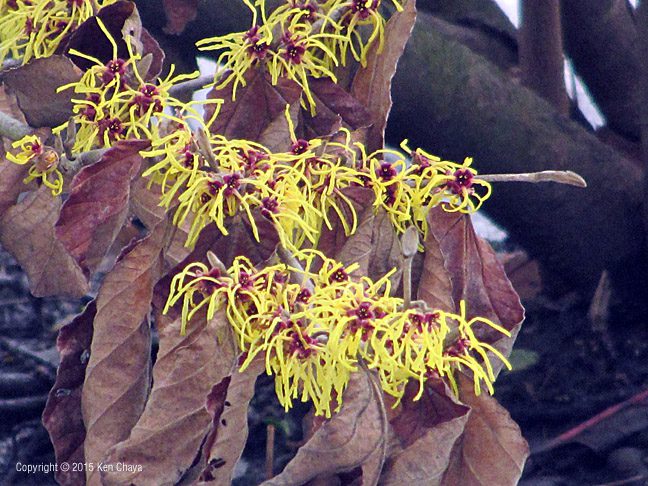
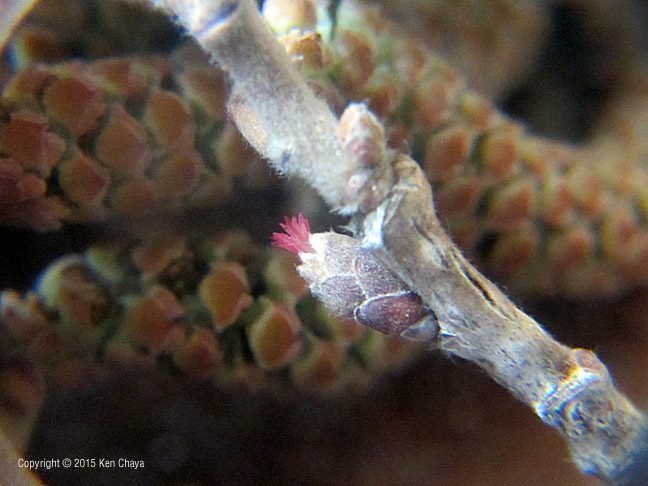
Spring witchhazel (Hamamelis vernalis) is already in blooms and still holding on to last year’s leaves (above, left). Also in bloom is the Turkish Filbert (Corylus colurna), the only specimen of its kind in Central Park (above, right). One has to look very precisely at this time of year in order to find its miniscule red flowers growing among the many male catkins that cover the tree before the leaves arrive (visible in the background).
The author of this article, Ken Chaya, is a New York City artist, designer, and urban naturalist. He spent over two and half years walking every acre of Central Park in order to map its many trails, highlight its stunning architecture and landscape features, and most importantly, locate and identify thousands of its magnificent trees. Ken Chaya extends an invitation to Into the Woods participants to accompany him on his nature walks in Central Park through the seasons. Information about Ken’s walks are listed on the Into the Woods Calendar of Events page and you can contact him at Kenchaya@verizon.net.
To Protect Monarch Butterflies from Extinction, U.S. Fish and Wildlife Service Provides $3.2 Million in Funds
by David Jakim, 2/9/15
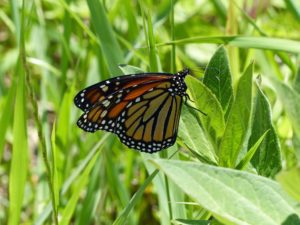
Monarch Butterfly on Swamp Milkweed
This U.S. Fish and Wildlife Service funding comes shortly after a Petition to Protect the Monarch Butterfly Under the Endangered Species Act was accepted for review. The petition, written by the Center for Biological Diversty, includes our most up-to-date knowledge about the natural history, population, distribution, threats, and the critical habitat needed to protect this creature. The report is based largely upon data, maps, and figures provided by citizen science efforts such as Journey North, the Monarch Larval Monitoring Project, Monarch Alert, Monarchs in the Classroom, The Monarch Teacher Network and Monarch Watch. The petition is a great resource for the study of the Monarch butterfly and a link is provided here.
Later this month we will have our second annual Monarchs in the Classroom workshop in time with the beginning of the Spring migration! Monarch butterflies typically begin their journey north from inland Mexico in late February to early March. They start laying eggs on milkweeds in the southern United States between mid-March and the beginning of May. We can expect Monarchs to begin to arrive in New York by June. Last year, the first Monarch butterfly to be reported in New York City was on May 20th, captured in this photograph by David Jakim.
For up-to-date news on Monarch butterflies, contribute at Journey North!
Snowy Owl
By Christina Teran, 1/10/15
On Tuesday, December 30, in College Point, Queens, at approximately 8am as I was getting ready for work, I looked out the window and I saw an unusual bird on top of a house behind mine. I kept looking to see what it was, shortly afterwards, the bird moved its head all the way around and even faced me for a little bit. This confirmed that I was in fact seeing an owl.
World of Birds on Queens College Campus!
Never have I seen anything so surprising on Queens College campus as what I saw when with Into the Woods classes when we set out to record every single bird over a period of fifteen minutes. In November of 2013, we saw the silhouette of a large, hunched-over bird, wearing what looked like a feathered cap, looming over the library bell-tower. “Is that a black-crowned night heron, a fishing bird, atop the bell-tower? What is it doing up there?” At the same time, a Great Blue Heron, our largest fishing bird, fly north by the same bell-tower. On December 6th, 2014, we saw a opossum walk across the crab-apple orchard, apparently to get to the other side (depicted below).
On every occasion we observed two red-tailed hawks. Red-tailed hawks are relatively large birds of prey, with a four-foot wing span. On one day in 2014, we observed an aerial chase of one hawk flying after a flock of pigeons over the quad. Red-tailed hawks can be seen on campus almost any day. Usually they are perched viligant on buildings and light-posts, or riding thermal vents high in the sky. These birds are monogamous and can live to the age of thirty. A pair of these hawks nested on a fire escape above Colden Auditorium in the year 2012 that was carelessly destroyed by custodial staff. Rumor has it that they have taken to a new nest on the apartment buildings south of campus by Melbourne avenue.
In 2013, we observed starlings in abundance on trees above the quad. These birds with their winy calls can be seen gathering in the thousands on trees in select days. Starlings, an invasive species, were released in the US by a Shakespeare enthusiast who set out to introduce all the birds mentioned in Shakespeare to our area. A flock of mockingbirds can make clean work of all the invertebrates and seeds on the campus quad.
Every class recorded dozens of pigeons and several mourning doves, gulls, and house sparrows. House sparrows are probably NYC’s most common species, but are often overlooked. They are a drab species with an unremarkable ‘tweet’ call that typically perches on low-lying vegetation or hobbles on the ground after food.
Queens College’s resident mockingbird made an appearance on one observation day in 2014. This mockingbird spends a good portion of the year singing in the ornamental garden adjacent to the science building. Another mockingbird has been rearing young with a nest in a tree in the crap-apple orchard adjacent to the science building.
For more stories on campus birds and animals, see “Notes of a Queens College Naturalist,” a blog about local flora and fauna by David Jakim.
Queens College has a New Interactive eBird Website for recording observations like the ones made at World of Birds workshops. Please visit the page and contribute to our growing dataset. You can also create your own website for a study area of your own or your class. If you have any you have any questions, you can contact me at David.Jakim@qc.cuny.edu. Happy Hunting!
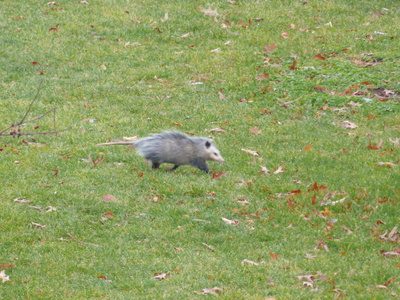
The First Monarch Butterflies Have Arrived in Mexico
Shared by David Jakim, 11/6/14, 2014
Biologist Felipe Martinez Meza, Assistant Director of Mexico’s Monarch Butterfly Biosphere Reserve, reports that on November 2nd, “Faithful to their cultural and ancestral tradition, the monarchs have begun to arrive in their overwintering palace in Mexico. Unlike last year, when the Monarchs came late, around the 10th of November, this year they arrived at their appointed time, on the Day of the Dead in Mexico.” For more on this story and for updates, visit Journey North.


